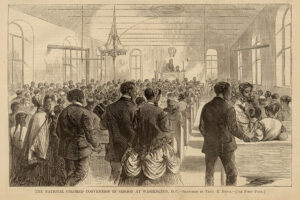The Colored Convention Movement

Here’s more of the story. Hello, I’m Susannah Koerber, Chief Curator and Research Officer of the Indiana State Museum and Historic Sites. I’ll be talking about the Colored Conventions Movement. The Colored Conventions Movement was one of the major efforts/initiatives used by the Black community to organize in response to major issues of the day. The first Colored Convention was held in Philadelphia in 1830, partially in response to a major race riot in Cincinnati the previous year and the newly enacted Ohio laws that severely restricted Black people’s rights. Those laws would soon be replicated in other midwestern states, including Indiana. Black leaders from across the North met, including national figures like Frederick Douglass, who would be active in several conventions as were Martin Delany, Henry McNeal Turner, and Henry Highland Garnet. The movement lasted into the 1890s, with more than 200 state, regional and national conventions occurring. After the Civil War and the end of slavery, the convention movement expanded into the South. It served as a model for later organizations, including the NAACP. Certain topics appeared frequently at the conventions, including opposition to slavery and to African colonization, as well as efforts to win political and civil rights, fight the exclusion of Black people from schools and public accommodations and find ways to overcome limitations on economic opportunities. Voting and the ability to testify in court, fundamental to being able to protect one’s liberty and property, were always central. State Conventions often dealt with local issues as with the 1851 Indiana convention that was called in preparation for the new state Constitution, which denied many rights, including the vote, to Black Hoosiers and banned Black people from moving into the state. In the wake of the Civil War, there was another convention calling for equal rights in 1865. These issues were discussed at length along with possible actions that the Black community could take in response. The conventions were covered in the press and issued unified statements, including published minutes and proceedings that brought the debates to a wider audience. In Washington, DC, conventions were held around the 14th and 15th Amendments. These conventions used their political connections to great advantage. The January 1869 convention coincided with the final debates around the 15th Amendment. The convention’s honorary members included many of the sympathetic Congressmen and other officials who would be part of those debates, including Charles Sumner, as well as prominent Black and White abolitionists. The convention sent delegates to meet with the House Judiciary Committee on suffrage, the Senate Committee on Military Affairs about equitable payment of bounties for those formerly enslaved, and with President-elect Ulysses Grant and Vice-president elect Schuyler Colfax, reminding them of the political support the Black community had provided.









